Banks beef up support for farming
China's banks have been pouring more funds into agriculture and rural areas this year as the country seeks to advance rural vitalization, latest data from the national financial watchdog showed.
Experts said stronger financial support for rural vitalization is expected to add steam to the high-quality development of agriculture and rural areas, which will eventually help stabilize domestic prices, increase aggregate demand and inject more strength into the overall economy.
As of the end of August, China's outstanding farming-related loans topped 54.98 trillion yuan ($7.53 trillion), up more than 15 percent year-on-year, according to the National Financial Regulatory Administration.
Such loans were aimed at increasing support for industrial upgrades in rural areas, the development of certain industries like intensive processing of farm products and the growth of new business formats.
The loans have also supported the construction of agricultural industrial parks, to gradually form a rural industrial development model with industrial parks and industrial clusters as the foundation.
"Agriculture is the foundation of other economic sectors like manufacturing and services. Consolidating the development of agriculture and strengthening infrastructure construction in rural areas can support national economic growth," said Li Chang'an, a professor at the Academy of China Open Economy Studies, which is part of the University of International Business and Economics in Beijing.
"More importantly, as residents in rural areas account for nearly 40 percent of China's population, support for rural areas can help tap their demand potential and boost aggregate demand," he said.
This deserves urgent attention as the relatively weak overall demand has become a major challenge for the Chinese economy.
According to the NFRA, since the start of this year, lenders have been ramping up efforts to provide better financial services to new agricultural market entities like farmer cooperatives, family-run farms and large-scale breeding farms.
Banks' measures so far included lowering interest rates on loans and extending credit loans. As of the end of August, outstanding loans to rural households stood at 16.41 trillion yuan, up 12.5 percent year-on-year.
This helped boost farming-related loans extended by major State-owned banks. By the end of August, outstanding loans of Industrial and Commercial Bank of China totaled almost 4 trillion yuan, up 20 percent from the start of the year. Such loans given by some other banks such as Agricultural Bank of China, Postal Savings Bank of China and Bank of Communications all surpassed 15 percent during the period.
Zhou Maohua, an analyst at China Everbright Bank, said official data showed that the financial services industry has been providing increasingly stronger support to agriculture, rural areas and rural residents.
"This trend is supporting the continuous structural upgrades of agriculture ... The high-quality development of agriculture is key to ensuring China's food security and price stability," Zhou said.
"Agriculture has been a long-term weak point in the Chinese economy, so stronger financial support will help stabilize agricultural product supply and prices, and promote the healthy interplay between agriculture and financial services."






















































First, please LoginComment After ~